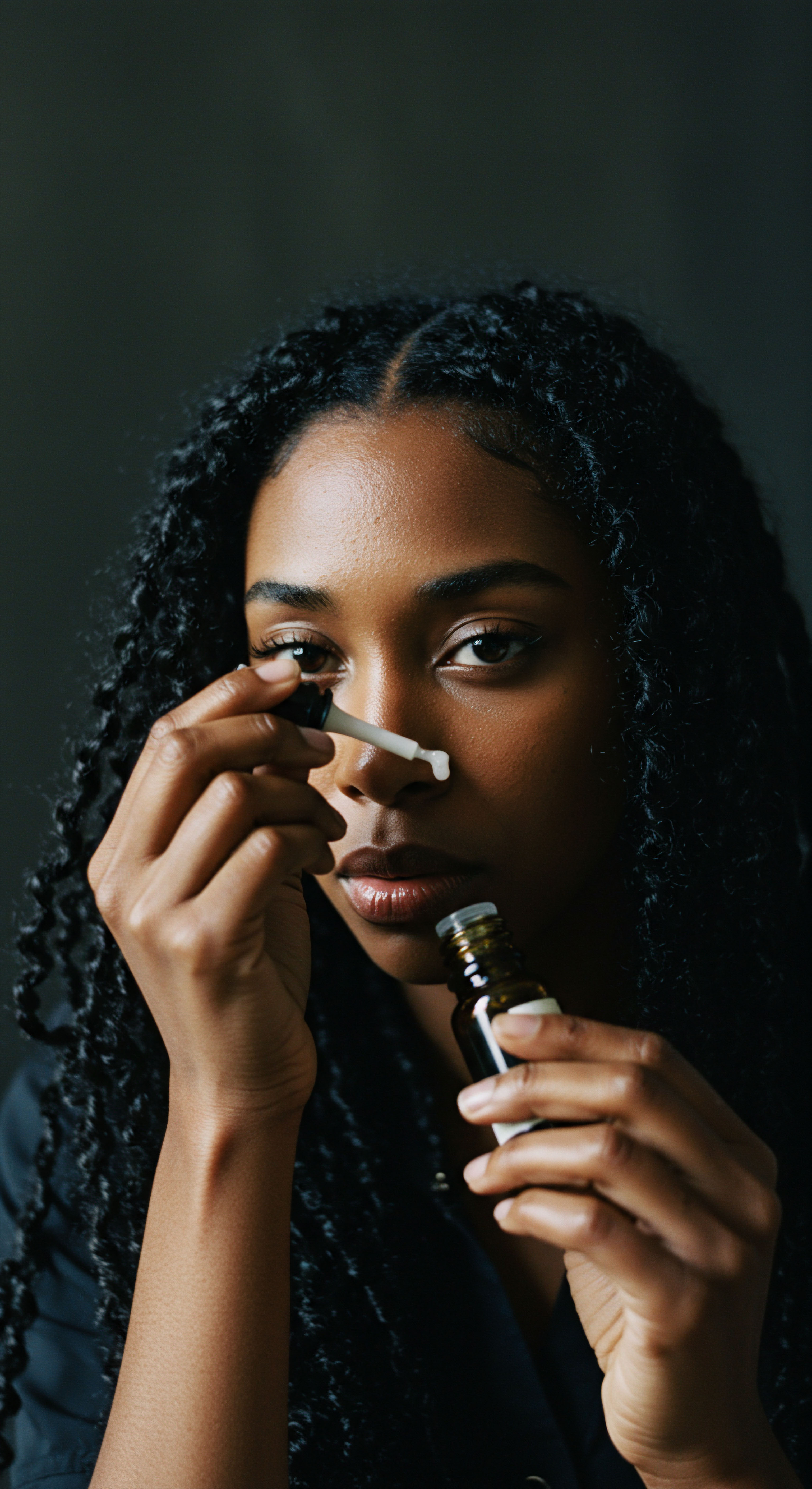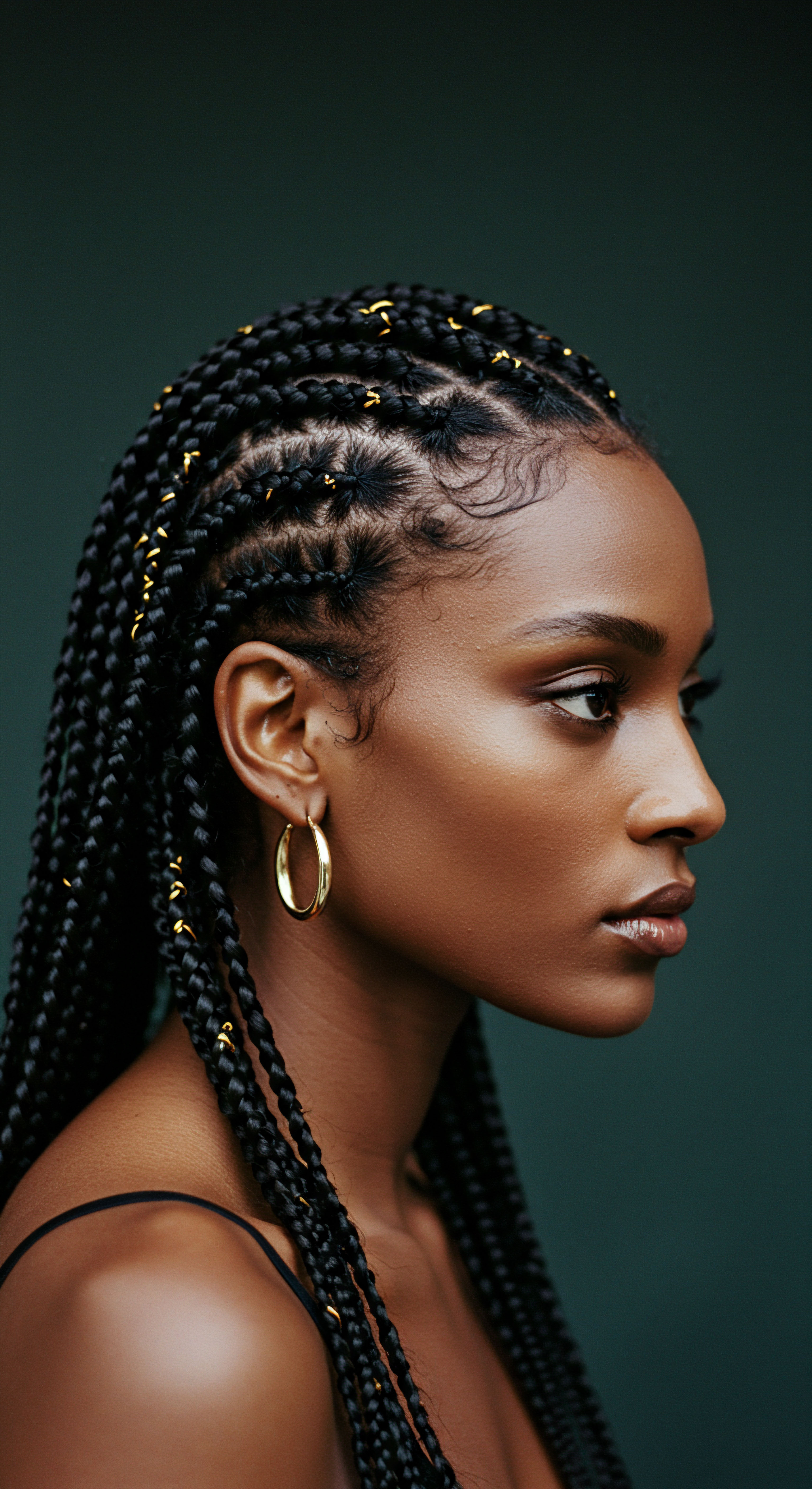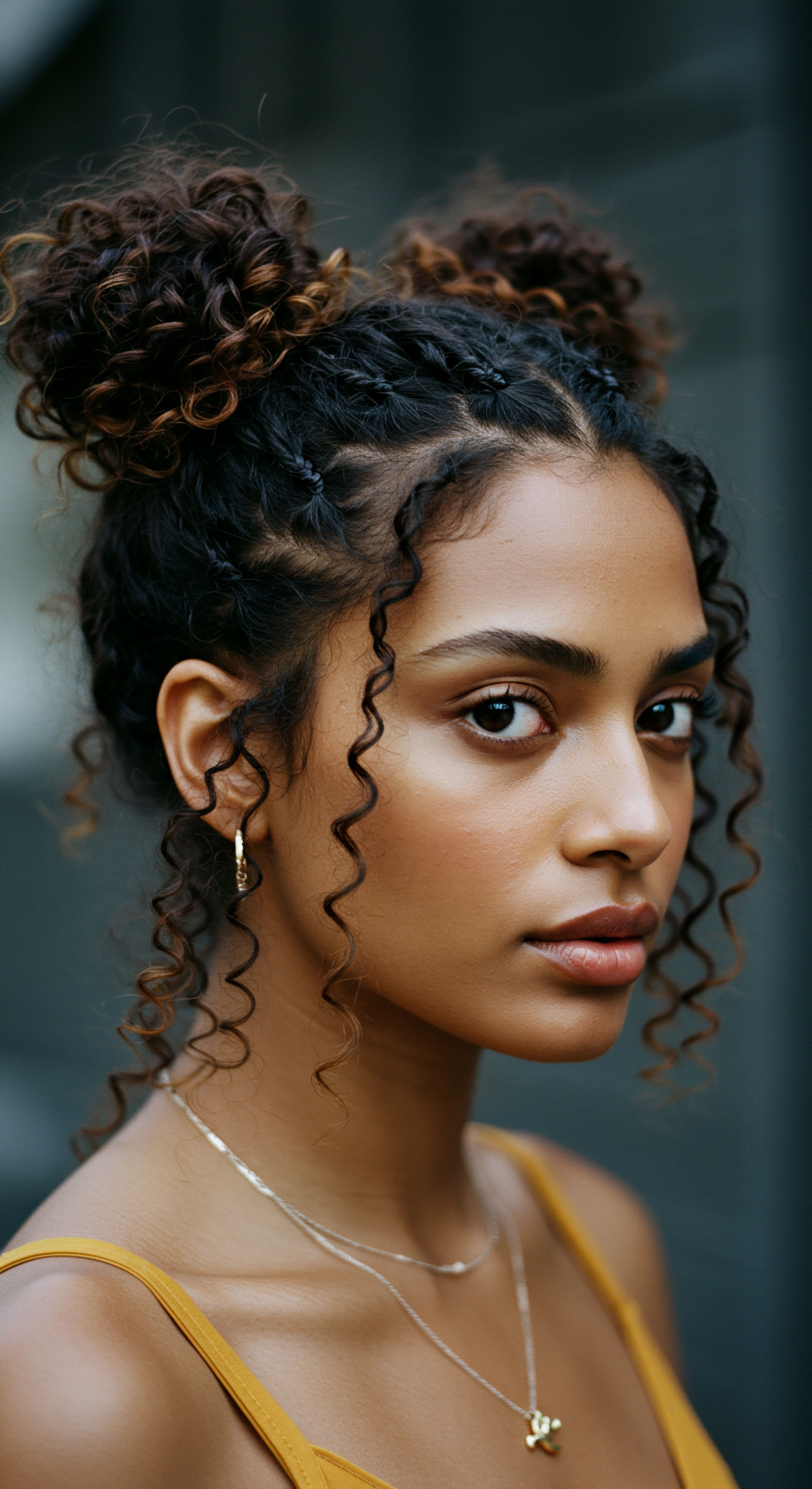
Roots
The quiet hours of night, often perceived as a period of restorative slumber, hold a subtle, often unseen dialogue with our textured strands. As we surrender to dreams, our hair, too, engages with its surroundings, a silent interaction that profoundly shapes its vitality. For generations, wisdom passed down through hands and whispers has spoken of protecting our crowns, particularly as the day fades into darkness.
Yet, a common companion in many sleeping spaces, the cotton pillowcase, often unwittingly becomes a source of silent contention for the delicate architecture of textured hair. To truly grasp why this familiar fabric falls short, we must first descend into the very essence of hair itself, its foundational anatomy, and the unique characteristics that distinguish coily, kinky, and wavy patterns.

The Microscopic Universe of Textured Hair
Each strand of hair, regardless of its visible pattern, is a complex biological marvel. At its core, the hair shaft comprises three primary layers ❉ the medulla, the cortex, and the cuticle. The medulla, the innermost layer, might be absent in finer hair types.
The cortex, the thickest layer, houses the keratin proteins and melanin that determine hair’s strength, elasticity, and color. It is the cuticle, the outermost protective shield, that concerns us most when considering nighttime preservation.
The cuticle consists of overlapping, scale-like cells, much like shingles on a roof. In straight hair, these scales lie relatively flat. However, in textured hair, particularly those with tighter coils and kinks, the cuticle scales naturally tend to be more raised and uneven.
This inherent structural difference, a gift of our genetic heritage, creates a surface that is more susceptible to friction. When these scales are disturbed, they lift further, exposing the delicate cortex beneath and increasing the potential for moisture loss and mechanical stress.

Hair’s Unique Shape and Vulnerability
The distinctive curl patterns of textured hair—from gentle waves to tightly packed coils—are not merely aesthetic variations; they are fundamental structural differences. The elliptical or even flattened shape of the hair follicle dictates the strand’s curvature as it grows. This curvature means that textured hair does not lie flat against itself or other surfaces in the same way straight hair might.
Instead, it creates points of contact along the length of the strand, where the hair rubs against itself and anything it touches. These points of contact are inherently more vulnerable to friction.
Consider a tightly wound spring; every curve represents a potential point of weakness if external forces apply pressure. Similarly, the numerous bends and turns in textured hair mean that a single strand can experience multiple points of friction against a rough surface during the restless movements of sleep. This continuous rubbing, though seemingly gentle, accumulates over hours, leading to significant wear and tear.
The intrinsic structure of textured hair, with its raised cuticles and numerous points of contact, renders it particularly susceptible to friction and moisture depletion from everyday materials.

Moisture’s Quiet Escape
Textured hair, by its very nature, often struggles with retaining moisture. The journey of natural oils, or sebum, from the scalp down the coiled hair shaft is more arduous than on a straight strand. This slower distribution means that textured hair often experiences dryness, making it inherently more fragile and prone to breakage. When this dryness is compounded by external factors, the hair’s resilience diminishes significantly.
Cotton, a hydrophilic material, possesses a remarkable capacity to absorb water. While this quality makes it excellent for towels, it becomes a detriment when it comes to hair. As textured hair, already inclined towards dryness, rests upon a cotton surface for hours, the fabric acts like a silent siphon, drawing precious moisture directly from the hair strands.
This moisture depletion exacerbates the hair’s natural tendency towards dryness, leaving it feeling parched, brittle, and more prone to tangles upon waking. The very material meant to provide comfort inadvertently contributes to a cycle of dehydration for our strands.

Ritual
Having explored the foundational elements of textured hair’s unique architecture and its inherent thirst for moisture, our focus now shifts to the practical realm of nighttime care. The ritual of preparing for sleep is not merely about comfort; it is a conscious act of preservation for our hair. For many with textured hair, this evening practice has evolved from necessity into a sacred moment of protection.
The choice of sleep surface, a seemingly minor detail, holds profound sway over the health and appearance of our strands come morning. It is here, in the quiet hours of rest, that the cotton pillowcase reveals its limitations as a guardian of textured hair.

The Cotton Pillowcase and Hair’s Nightly Dance
The average person shifts positions approximately 10 to 30 times each night. Each movement, each turn of the head on a cotton pillowcase, creates friction against the hair. The microscopic fibers of cotton, while soft to human skin, possess a coarse texture when viewed under magnification.
These fibers act like tiny, abrasive hooks, catching and snagging the delicate cuticle scales of textured hair. This continuous mechanical stress leads to several undesirable outcomes that disrupt the hair’s natural integrity.
The repeated snagging and pulling cause the raised cuticle scales to lift further, or even chip away. This damage exposes the inner cortex, making the hair more vulnerable to environmental aggressors and further moisture loss. The result is often hair that feels rough, appears dull, and is riddled with tangles and knots. The effort put into a daytime styling regimen can be undone in a single night by the seemingly innocent cotton fabric.

Why Does Cotton Promote Tangles and Breakage?
The inherent friction of cotton surfaces significantly contributes to the formation of tangles and knots in textured hair. As hair rubs against the fabric, individual strands become intertwined and matted. This is particularly pronounced in coily and kinky textures, where the natural curl pattern already predisposes hair to intertwining. The abrasive nature of cotton exacerbates this tendency, leading to more stubborn tangles that are difficult to resolve without causing further damage.
When morning arrives, the attempt to detangle hair that has spent hours in frictional contact with cotton often results in excessive shedding and breakage. The force required to separate matted strands can physically snap hair fibers, especially those already weakened by dryness or cuticle damage. This cycle of nighttime damage and morning breakage undermines efforts to retain length and maintain overall hair health.
The coarse nature of cotton fibers acts as an abrasive surface, leading to cuticle damage, tangles, and increased breakage for textured hair during sleep.
A study published in the Journal of Cosmetic Science, while focusing on hair fiber damage from different textile materials, indicated that fabrics with higher surface roughness and friction coefficients contributed to greater cuticle wear and increased protein loss from hair strands. Though not specifically naming cotton as “less ideal” for textured hair, the underlying principles of friction and abrasion on hair fibers remain constant. This research, focusing on the mechanical properties of hair-textile interaction, underscores the detrimental effect of rough surfaces on hair integrity.

The Case for Silk and Satin
In stark contrast to cotton, materials like silk and satin offer a smoother, less abrasive surface. These fabrics possess a tightly woven, smooth fiber structure that allows hair to glide over them with minimal friction. This reduction in friction translates directly into less mechanical stress on the hair shaft.
Consider the difference in how water moves across a rough, porous surface versus a slick, polished one. Hair behaves similarly. On silk or satin, hair strands encounter fewer snags and pulls, preserving the integrity of the cuticle layer. This means less tangling, less frizz, and significantly less breakage.
Furthermore, unlike cotton, silk and satin are not highly absorbent. They allow the hair to retain its natural moisture and any applied products, ensuring that the hair remains hydrated and nourished throughout the night.
| Fabric Type Cotton |
| Surface Texture Rough, fibrous |
| Moisture Absorption High (hydrophilic) |
| Friction Level High |
| Impact on Textured Hair Increased frizz, tangles, dryness, breakage, cuticle damage |
| Fabric Type Silk |
| Surface Texture Smooth, tightly woven |
| Moisture Absorption Low (hydrophobic) |
| Friction Level Very Low |
| Impact on Textured Hair Reduced frizz, minimal tangles, moisture retention, cuticle preservation |
| Fabric Type Satin |
| Surface Texture Smooth, synthetic weave |
| Moisture Absorption Low (hydrophobic) |
| Friction Level Low |
| Impact on Textured Hair Reduced frizz, minimal tangles, moisture retention, cuticle preservation |
| Fabric Type Choosing a sleep surface with low friction and low absorbency is crucial for preserving textured hair health. |

Relay
Beyond the immediate tactile experience and the visible signs of morning hair, there lies a deeper current, a convergence of science, heritage, and the subtle energies that shape our perception of beauty and care. Why does the simple choice of a sleep surface resonate so profoundly within the textured hair community? This question beckons us to look beyond surface-level explanations and to consider the intricate interplay of biological vulnerability, cultural significance, and the enduring quest for holistic wellbeing. The less-than-ideal nature of cotton for textured hair protection at night is not merely a matter of fiber mechanics; it speaks to a more expansive understanding of hair’s role in identity and self-care.

The Bio-Mechanical Realities of Fiber Interaction
The science behind textile-hair interaction extends beyond simple friction. It delves into the bio-mechanical forces at play when hair, a protein filament, repeatedly contacts a fabric surface. Research in tribology, the study of friction, lubrication, and wear, offers a compelling framework for understanding this dynamic. The surface energy of a material, its microscopic topography, and its hygroscopic properties (how it interacts with moisture) all contribute to the degree of damage inflicted upon hair.
Cotton fibers, being cellulosic, possess a higher coefficient of friction against human hair compared to protein fibers like silk or synthetic satin. This difference is quantifiable. A higher coefficient of friction means that more force is required to slide the hair over the surface, leading to increased shearing forces on the hair cuticle.
These forces cause the delicate cuticle scales to lift, abrade, and eventually break away. Over time, this cumulative damage compromises the hair’s structural integrity, leading to increased porosity, reduced elasticity, and a heightened susceptibility to environmental damage.

What is the Impact of Surface Energy on Hair Health?
Surface energy refers to the excess energy at the surface of a material compared to its bulk. Materials with high surface energy tend to interact more strongly with other substances, including hair. Cotton, with its exposed hydroxyl groups, exhibits higher surface energy, making it more prone to forming hydrogen bonds with the water molecules within the hair shaft.
This attraction facilitates the transfer of moisture from the hair to the fabric, contributing to dryness. In contrast, silk, a protein fiber, has a lower surface energy and a smoother molecular arrangement, which minimizes this interaction and allows hair to retain its hydration.

The Cultural and Psychological Echoes of Hair Protection
For centuries, across diverse cultures, nighttime hair wrapping and protection rituals have held deep significance. These practices were not solely about aesthetics; they were acts of preservation, symbolizing care, respect, and a connection to ancestral wisdom. From intricately tied headwraps to specially designed sleep coverings, the intention was always to safeguard the hair from the elements, including the abrasive surfaces of sleep. The modern preference for silk or satin pillowcases and bonnets is a contemporary manifestation of this ancient wisdom, adapted to modern materials and understanding.
The psychological impact of waking to tangled, dry, or frizzy hair cannot be understated. For individuals with textured hair, who often navigate societal pressures regarding hair appearance, a difficult hair day can affect self-perception and confidence. Conversely, waking to soft, manageable strands, preserved by thoughtful nighttime care, fosters a sense of empowerment and self-acceptance. The ritual of protecting hair at night becomes a quiet act of self-care, a declaration of worth that extends beyond mere vanity.
Beyond friction, cotton’s high surface energy and hydrophilic nature actively deplete hair’s moisture, accelerating cuticle degradation and undermining its structural resilience.

The Interconnectedness of Hair and Wellness
Our hair is a barometer of our overall wellbeing. What we put into our bodies, the stress we experience, and how we care for our physical selves all manifest in the health of our hair. The choice of sleep protection is not isolated; it is a component of a larger holistic approach to hair health. Ignoring the detrimental effects of cotton on textured hair would be akin to meticulously watering a plant while placing it in harsh, drying conditions.
A 2017 study by A.M. Kulkarni and S.V. Kulkarni, published in the International Journal of Advanced Research in Engineering and Technology, explored the ‘Effect of Fabric Surface on Hair Friction and Damage’.
While their research encompassed various hair types and fabric compositions, their findings consistently showed that fabrics with rougher surface topography and higher coefficients of friction, like certain cotton weaves, led to greater damage to the hair cuticle, measured by increased scale lifting and eventual breakage. This research provides a tangible, scientific backing to the anecdotal evidence long shared within textured hair communities, highlighting the direct link between fabric surface properties and hair fiber integrity.
This scientific insight reinforces the wisdom that has guided generations ❉ mindful interaction with our hair, even during sleep, is paramount. Choosing sleep surfaces that honor the unique needs of textured hair contributes not only to its physical vitality but also to the broader sense of self-care and respect for our natural heritage. It is a quiet rebellion against practices that inadvertently diminish the inherent beauty and strength of our strands.
- Coefficient of Friction ❉ This quantifiable measure determines the ease with which two surfaces slide past each other, directly influencing the mechanical stress on hair cuticles.
- Hydrophilic Properties ❉ Cotton’s attraction to water molecules means it actively absorbs moisture from hair, leading to dryness and increased brittleness.
- Cuticle Integrity ❉ The outermost protective layer of hair, the cuticle, is highly vulnerable to friction, with damage leading to porosity and breakage.

Reflection
As the quiet hum of night descends, the choice of what cradles our textured strands holds more weight than a fleeting thought. It is a quiet testament to understanding, a subtle act of honoring the unique biology and cultural journey of our hair. The soft, familiar embrace of cotton, while comforting to skin, reveals itself as a less-than-ideal companion for our curls, kinks, and waves, drawing away precious moisture and inviting the very friction we seek to avoid.
This realization is not a call for drastic change, but a gentle invitation to consider the silent interactions that shape our hair’s vitality. In choosing smoother, less absorbent alternatives for our sleep sanctuaries, we participate in a quiet revolution of care, ensuring that each morning greets us not with struggle, but with strands that reflect the deliberate, gentle wisdom of the night.

References
- Kulkarni, A. M. & Kulkarni, S. V. (2017). Effect of Fabric Surface on Hair Friction and Damage. International Journal of Advanced Research in Engineering and Technology (IJARET), 8(5), 114-120.
- Robbins, C. R. (2012). Chemical and Physical Behavior of Human Hair (5th ed.). Springer.
- Bhushan, B. (2013). Principles and Applications of Tribology (2nd ed.). Wiley.
- McMullen, R. L. & Jachowicz, J. (2018). The Science of Hair Care. CRC Press.
- Ladin, D. A. & Sager, L. A. (2007). The Art and Science of Hairdressing. Milady.
- Franbourg, A. Hallegot, P. Baltenneck, F. Freyssinet, J. M. & Bouillon, C. (2003). Current research on ethnic hair. Journal of the American Academy of Dermatology, 48(6), S115-S119.
- Gavazzoni Dias, M. F. (2015). Hair Cosmetics ❉ An Overview. International Journal of Trichology, 7(1), 2-15.